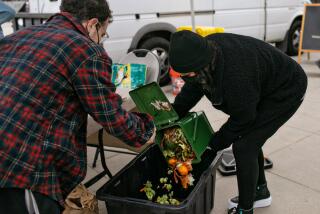Compose your own compost
- Share via
Homemade compost is the secret ingredient in many gardens and what’s missing in many more. It’s why some gardeners get endless bouquets from their beds and tomatoes that are plump, tasty and blemish-free.
This good stuff is simply decomposed or partially decomposed organic matter. English gardening books confuse this issue by calling potting mixes composts, while other gardeners sometimes use the term to describe concentrated fertilizer-like mixes that contain manures. You can’t buy homemade compost by the bag, though there are a few commercial composts, including one made by the city of Los Angeles from the stuff you throw into those green cans.
The ingredients for homemade are cheaper than flour and water. All it takes are clippings and fallen leaves, stuff you’d normally have to get rid of. You don’t even need water, but moisture can greatly speed the composting process. And for those of us who are compulsively thrifty, we can save money by making compost, though admittedly not much. In time, you can stop buying soil amendments and fertilizers, unless you have lots of potted plants. Potted plants usually need fertilizing with something stronger than compost, and they grow best in commercial potting mixes (although you can make your own using compost as one of the ingredients).
To make compost, simply pile the materials in a corner and let them slowly rot. In Southern California, this may take some time, because moisture greatly speeds decomposition and we have little, but I’ve seen piles that turned into wonderful stuff with no moisture other than rain. To speed things up, keep the pile moist and use an equal mixture of green matter from the garden and dead, brown matter.
Buy or build a bin. It helps to have something to keep the compost in, and the simplest compost bin is a 3-foot-tall cylinder made of welded wire with a 1-by-2-inch mesh. Bins conserve heat and moisture, so they speed composting. You can build more elaborate ones or buy ready-made bins. Some municipalities or government agencies, including Los Angeles County, sell them quite cheaply ($20; www.smartgardening.com) or even give them away.
Add brown stuff. The one essential ingredient is dead, brown material from the garden, such as what you’d find on a forest floor. Fallen leaves, needles and twigs sustain the forest, and they can do the same for your garden. Throwing these out is like tossing gold coins into the street. Well, almost.
Pile them up and wait until they partially decompose -- so the chunks are about half an inch to an inch -- and they make a great mulch, better than any you can buy. Let this material completely decompose and it becomes a super soil amendment, fluffing your soil up like a shaken down comforter. As a mulch or amendment, compost is also a mild fertilizer, which is just what most mature gardens need.
Add green stuff. Green materials, such as grass clippings and other prunings, add nitrogen to the compost pile, and nitrogen, a basic element in fertilizers, greatly speeds composting. Green material should be mixed about half-and-half with dead, brown material. Make sure the two are thoroughly combined and you’ll have the near-perfect pile. Use too much green material, or let it get matted down, and the pile will stink. Never simply pile up fresh, wet grass clippings by themselves. They can breed flies, like a pile of raw hamburger.
Chop it up (optional). Small things decompose faster, so consider slicing and dicing. Some folks (including those at arboretums and city agencies) use power shredders and chippers, but I’ve found that a machete works nearly as well in the typical small garden. On an old log, I whack away at fistfuls of material, so pieces end up 3 to 6 inches long. Watch your fingers.
Add water (optional). If you keep the pile moist like a squeezed-out sponge, it will really cook and be finished in a matter of weeks instead of months. I time my composting so most of it gets made in winter. I save all of autumn’s leaves, add the tops of perennial plants that get cut back in late fall and pulled-out vegetables, then let winter’s rains keep the pile moist. By spring, I’ve got compost for use as a water-conserving and nourishing summer mulch, or I can dig it into the vegetable and flower beds. At other times of the year, I have to sprinkle the pile to keep it moist.
What not to compost. Certain things should be left out of the compost pile. Think twice before adding anything from the kitchen. Meats and less obvious kitchen scraps will breed flies, while garden debris (other than grass clippings) never do. A very few kitchen scraps are natural additions, such as coffee grounds, carrot tops and wilted lettuce. For gardeners, it’s probably more important to not toss weeds into the pile unless you are sure they have not gone to seed and do not have bulbs, tubers or stoloniferous roots, such as Bermuda grass or oxalis. Adding weeds to compost, which you then spread around the garden, is not a good idea.
Do not expect thorns to quickly decay in home piles, so chuck rose prunings, blackberries and other spiny species into that green-waste recycling can. Actually, you will probably want to toss any woody material much thicker than a lollipop stick into the green can unless you have a shredder.
There are as many recipes for homemade compost as there are for chicken -- maybe more. Using some of these, you can make compost that’s ready in weeks, or even days. Other concoctions add manures, which make them more like a fertilizer. But even the simplest pile will greatly improve soils and plant health. Best of all, it’s the completely natural way to do so.






